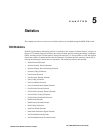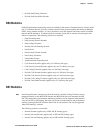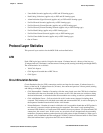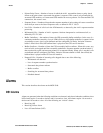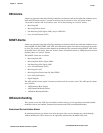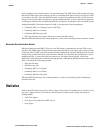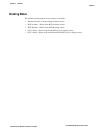
5-5
Cisco MGX 8240 Hardware User’s Guide
Release 3.0, Part Number 78-10728-01, July 2000
Chapter 5 Statistics
Alarms
DS3 Alarms
Alarms are generated when the following conditions are detected, and cleared when the conditions clear.
LOS and LOF alarms require 2 seconds to declare and 16 seconds to clear. AIS alarms require
1.6 seconds to declare and 10 seconds to clear. All of the following are “critical” alarms.
• Receiving AIS
• Receiving Yellow Alarm
• Not Receiving Valid Signal (LOS) (only for DS3 I/O)
• Loss of Frame Pointer (LOF)
SONET Alarms
Alarms are generated when the following conditions are detected, and cleared when the conditions clear.
Line and Path AIS, RDI, FERF, LOS, LOF, and LOP alarms require 2 seconds to declare and 16 seconds
to clear. The severity of these alarms depends on whether the line is protected using SONET APS. If one
of the APS lines is still active, these are “minor” alarms. If both lines alarm, or APS protection has been
disabled, these are “critical” alarms.
The SONET alarms are as follows:
• Receiving Path AIS
• Receiving Path Yellow Signal (RDI)
• Not Receiving Valid Signal (LOS)
• Loss of Frame Pointer (LOF)
• Receiving Line AIS
• Receiving Line Failure from Far End (FERF)
• Loss of Payload Pointer
• Signal Degrade
The APS specific alarms require 2 seconds to declare and 16 seconds to clear. The APS specific alarms
are as follows:
• APS Protection Byte Failure
• APS Channel Mismatch Failure
• APS Mode Mismatch Failure
CES Alarm Handling
This section covers how CES Service Interface alarms and loss of cells (persistent reassembly buffer
underflow) alarms are handled. Structured and unstructured CES are handled differently.
Unstructured Service Interface Alarms
In unstructured mode, any alarms received at the input of the service interface are carried through
without modification. These alarms can be optionally monitored by the MGX 8240 cards.



